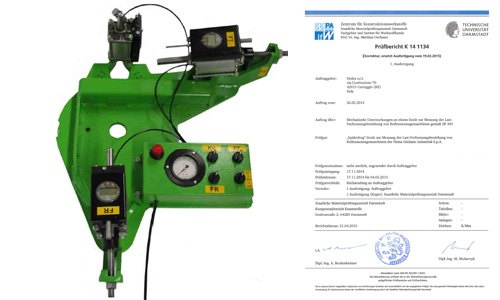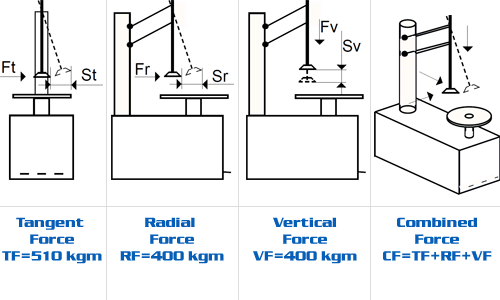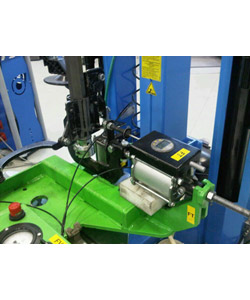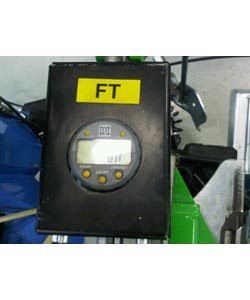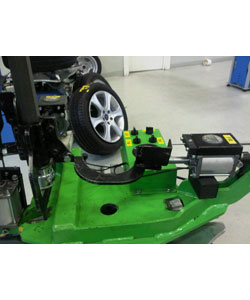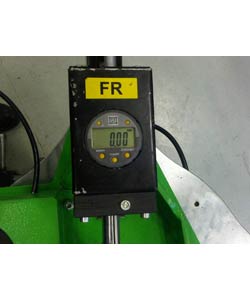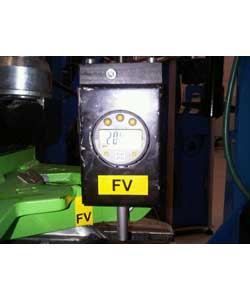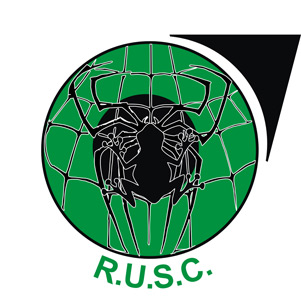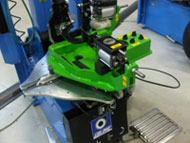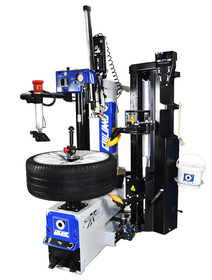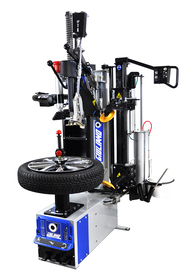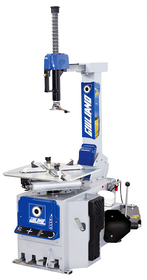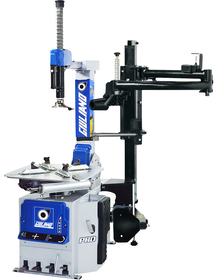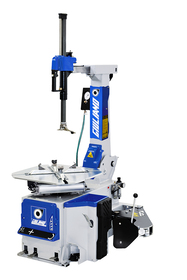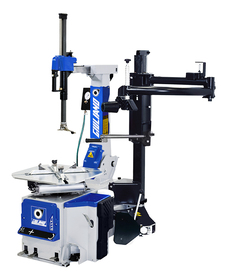Resistance Under Stress Coefficient
Spiderfrog is an innovative measuring device, certified in Germany by Staatliche Materialprüfungsanstalt (MPA), Darmstadt, company credited by DaKKs. Spiderfrog has been especially designed by Giuliano Group in order to check and measure bending and torsion of tyre changers' main parts under stress, which typically occurs during tyre mounting/demounting operations. Such a stress is determined by a combination of forces which are normally activated during tyre rotation, when the tyre changer's operating arm is engaged and working with tyre and rim, to mount and/or demount the tyre bead over the rim:
- A Tangent Force, left-to-right or right-to-left;
- A Radial Force, front-to-back and back-to-front;
- A Vertical Force, up-down.
SPIDERFROG is clamped on a traditional turntable, with the size of a 16" rim, and its structure includes
electronic measuring systems connected to air operated cylinders, to simulate the main forces (and related stresses) involved in tire mount/demount operations.
Every electronic gauge measures the movement which is given by each single force applied to the tyre changer. Air cylinders have been sized in a proper way to simulate the highest possible power applied on each part of the tire changer, during mount/demount operation.
For example, cylinder connected to Tangent Stress measuring system has a 90mm. diameter, as we have calculated it will develop a max. tangent force of 510 kgm. (= same max. torque as a 16" RunFlat tire during its mount/demount operation's max effort).
Both cylinders connected to Radial Force and Vertical Force, instead, are 75mm. diameter, as they develop a max. radial and vertical torque of 400 kgm. (= equivalent to the max. torque of a 16" RunFlat tire during its mount/demount operation's max effort).
Every electronic gauge measures the movement which is given by each single force applied to the tyre changer. Air cylinders have been sized in a proper way to simulate the highest possible power applied on each part of the tire changer, during mount/demount operation.
For example, cylinder connected to Tangent Stress measuring system has a 90mm. diameter, as we have calculated it will develop a max. tangent force of 510 kgm. (= same max. torque as a 16" RunFlat tire during its mount/demount operation's max effort).
Both cylinders connected to Radial Force and Vertical Force, instead, are 75mm. diameter, as they develop a max. radial and vertical torque of 400 kgm. (= equivalent to the max. torque of a 16" RunFlat tire during its mount/demount operation's max effort).
Tangent Force is simulated by the cylinder assembled in SPIDERFROG back right corner. Once the cylinder is activated, electronic gauge shows, through a sensor placed against the bracket mounted on the operated arm, the value of operating arm swivelling left-to-right (right-to-left would be the same).
Radial Force is simulated by the cylinder assembled on SPIDERFROG front part. When activated, the electronic gauge shows the swivelling of operating arm back-to-front (front-to-back would be the same) under the torque developed by related cylinder.
Vertical Force is simulated by the cylinder assembled on SPIDERFROG back bottom part. When activated, the electronic gauge shows the swiveling of operating arm up-down under the torque
developed by the related cylinder.
Some notes must be mentioned, before reading data:
- Given that most popular tyre changers are using protecting devices for metal tools which may get in touch with rim surface during tyre mount/demount operations, all kinds of flexion of tyre changer arms and parts are important, when we want to avoid metal-to-metal contacts of tyre changer parts against the rim. This because we want to avoid damaging the rim during operation;
- At the same time, we want to reduce such kinds of flexion even to avoid tyre bead flipping off the mount/demount tool, causing damages not just at the rim, but at the tyre bead, too;
- Among the 3 different kinds of flexion mentioned above, Tangent Force (=TF), creating Tangent Stress (=TS) has (according to us) a reduced importance, when compared with the other ones, as it is involved ONLY in the first few mm. of every tyre rotation (both clockwise and counter-clockwise). In both cases, in fact, the “tangent stress” on mount/demount head is applied ONLY when we start rotation, and in the few mm. after that. As soon as we can pass the “first step”, the horizontal stress is released and tangent force is not important anymore, as it doesn't create a critical factor for stress, anymore;
- More important, instead, are Radial Force (=RF) and Vertical Force (=VF), which stay on tyre, rim and the whole tyre changer for the entire mount/demount operation. So, more important are related stresses caused (=RS and VS) on tyre changer.
- In any case, the final result we'll have is a combination of the 3, which is found by measuring the 3 forces together, all at the same time. This is why SPIDERFROG device is so useful: not just because it shows each single “force” and related “stress” in all directions, but because it can show the ”combination“ of all forces and related stresses at the same time;
- As it is clear now, the “Combined Stress” result (= CS) is not a simple calculation of the amounts shown in every single measurement, but instead it is the result of a measurement of all kinds of “Forces” all together, at the same time. This explains why you will find different data in the “Combination Forces”, if compared with those you find in the other measurements of the single forces.
Below is indicated the value of R.U.S.C. for Giuliano Automotive tyre-changers

